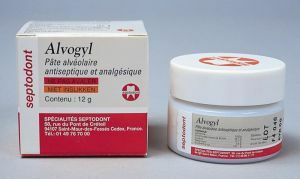 Alvogyl( Alvogyl) is used in dentistry for making alveolar bandages. It is an antiseptic, combined with a local anesthetic. Due to this, the drug has a complex effect in the area of the removed tooth.
Alvogyl( Alvogyl) is used in dentistry for making alveolar bandages. It is an antiseptic, combined with a local anesthetic. Due to this, the drug has a complex effect in the area of the removed tooth.
Alvogil is an antiseptic, analgesic and hemostatic compress for alveoli. He relieves pain, destroys pathogens and stops bleeding in the hole.
The paste contains iodoform, which has an antiseptic effect. In addition, the same is added to the butoform. This substance has a local anesthetic effect.
Hemostatic effect is achieved by the addition of penghavar.
Contents
- Form and Composition
- Properties of the preparation
- Indications for use
- Instructions for use
- Precautions
- What can I replace?
Form and Composition
Alvazil is available in 2 forms:
- paste;
- flagella.
The paste is packed in a jar weighing 12 grams. And the flagella are produced in a box containing 2 tubes with flagella 1 * 1 cm.
The Alvogil paste consists of:
- iodoform;
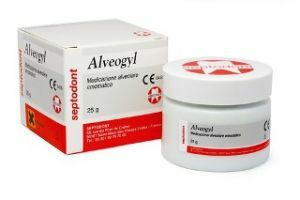
- butyl salt of diaminobenzoic acid, or butoform;
- eugenol;
- penghavar;
- filler lauryl sulfate sodium;
- calcium carbonate;
- olive oil;
- purified water;
- menthol flavor.
Flagellum consist of hygroscopic cotton wool impregnated with the above-described paste.
Properties of the preparation
The specificity of this preparation is its toxicity only at the place of use. The general effect on the body is impossible. Also, the formation of sores on the oral mucosa is excluded.
When the remedy is injected into the socket of the removed tooth, the pain sensations immediately decrease. The full medical effect comes in a few hours.
There is no need to get the drug out of the alveoli. It dissolves and promotes the formation of a substrate for the healing of the site of removal.
Secondary infection of the well is excluded. Microorganisms are immediately destroyed by iodoform. As a result, pain is less, and epithelialization occurs more quickly.
Indications for use
Alvogel is used in the following cases:
- for alveolar compressions after tooth extraction;
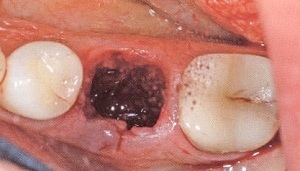
- with the disappearance of the blood clot from the socket of the removed tooth for one reason or another;
- if the inflammation develops in the hole and it is dry, ie the alveolitis develops;
- inadequate filling of the well with a blood clot, - this is possible when a sufficient large tooth with a large number of roots is removed and the wound is gaping;
- in the event that clot formation hampers the diseases associated with blood clotting disorder;
- as a prophylactic for a strong inflammatory process( in such situations, the drug is applied immediately after extraction of the tooth).
Instructions for use
Method of using Alvogyl:
- with sterile tweezers take a small amount of the substance from the jar;
- then gently roll the ball out of the mass;
- with another tweezers, the doctor inserts a ball into the well;
- if necessary, the wound can be sewn.
After 5-7 days the drug is completely absorbed. 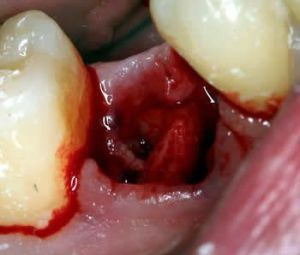
Method of using flagella:
- with sterile tweezers the flagella is removed from the tube;
- with sterile scissors cut off a small part of the flagellum about 15 cm long;
- then the doctor uses another pair of tweezers to lay the material in the well;
- if necessary, the hole is closed.
After 6-8 days, the preparation should be removed, since cotton wool is not resorbable.
Safety Precautions
When working with alvoys, the following important points should be considered:
- is excluded for use in the treatment of children younger than 12 years;
- at the same time it is only possible to apply a drug in the wells of five teeth, otherwise an overdose develops;
- should be used with caution in patients with thyroid disease;
- the drug should be replaced with another in case of individual intolerance to its components;
- athletes can positively react when performing doping tests.
What can I replace?
The most popular analogue of Alvozil is Capramin. It is a liquid that is used to stop bleeding from the capillaries. Its cost is much lower, like efficiency.
There is also a Swiss analog. It's called Alvopenga. The composition is similar, but differs in that the paste does not absorb. After 2-3 days 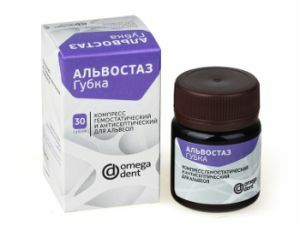 it must be removed from the hole. The cost is slightly higher, but insignificantly.
it must be removed from the hole. The cost is slightly higher, but insignificantly.
The Russian analogue is the drug Alvostaz. It is a collagen hemostatic sponge or flagella impregnated with a solution of iodoform. There are also variants when chlorhexidine with addition of metronidazole or chloramphenicol acts as antiseptics. The cost of this medicine is lower.
Another Russian analog, called Alvanes, is on the market. As an antiseptic, the composition contains cetrimide. The cost is comparable.
